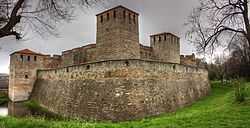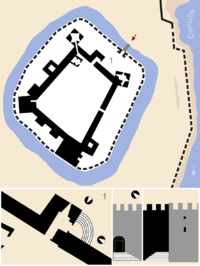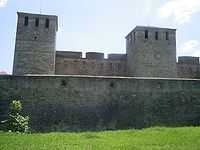Baba Vida


Baba Vida (Bulgarian: Баба Вида) is a medieval fortress in Vidin in northwestern Bulgaria and the town's primary landmark. It consists of two fundamental walls and four towers and is said to be the only entirely preserved medieval castle in the country. Baba Vida is situated at an altitude of 39 m.[1]
The construction of the fortress began in the 10th century at the place of an Ancient Roman watchtower. The building of Baba Vida is tied to a legend, according to which a Danubian Bulgarian king who ruled at Vidin had three daughters: Vida, Kula and Gamza. Prior to his death, he divided his realm among the three. Vida, the eldest, was given Vidin and the lands north to the Carpathians, Kula was awarded Zaječar and the Timok Valley, and Gamza was to rule the lands west up to the Morava. Although Gamza and Kula married to drunkard and warlike nobles, Vida remained unmarried and built the fortress in her city. The name of the castle means "Granny Vida".
Baba Vida served as Vidin's main defensive installation during the course of the Middle Ages and acted as the most important fortress of northwestern Bulgaria. The Baba Vida stronghold stood an eight-month-long siege by Byzantine forces led by Basil II, but was destroyed and once again erected during the rule of Ivan Stratsimir, as whose capital it served. Between 1365 and 1369, the fortress was in Hungarian hands. Vidin was suddenly attacked by the forces of Louis I of Hungary, but it took several months to conquer Baba Vida. In 1369, Ivan Sratsimir managed to regain control of his capital, albeit having to remain under Hungarian overlordship.
In 1388, the Ottomans invaded Sratsimir's lands and forced him to become their vassal. In 1396, he joined an anti-Ottoman crusade led by the King of Hungary, Sigismund, placing his resources at the crusaders' disposal. The crusade ended in the disastrous Battle of Nicopolis at Nikopol, Bulgaria, with the Ottomans capturing most of Sratsimir's domains shortly thereafter, in 1397.
The fortress played a role during the Ottoman rule of Bulgaria, serving as a weapon warehouse and a prison, also as residence for Osman Pazvantoğlu, as it has been no longer used for defensive purposes since the end of the 18th century.
Today, Baba Vida is a fortress-museum, where finds and intelligence about its history are kept. Being a popular tourist attraction, the fortress has been restored to its former appearance.
Gallery
-

Inside the fortress
-

-
-
-
-

-
-
-
-
-
-
Austrian-built tower from the 17th century
-
-
-

-

References
External links
| Wikimedia Commons has media related to Baba Vida. |
Coordinates: 43°59′35″N 22°53′12″E / 43.99306°N 22.88667°E










